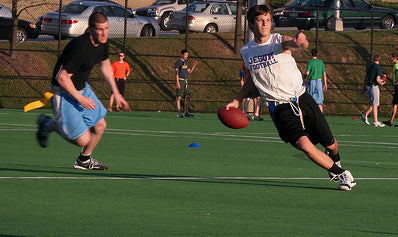Get Tough on Turf Toe
Posted by JB Smith, Co-Owner on

Ever wonder if the artificial field under your feet during your weekly pick-up football game is causing damage to your feet? Take a look at your big toe. Do you notice any swelling? People who often participate in consistent and vigorous activities on artificial turf fields are at greater risk of having the appropriately named “turf toe”, a condition in which the big toe swells and leads to pain at the toe base, near the ball of the foot.
Turf toe occurs when playing on turf because the shoe tends to stick and grab onto the surface with more force, causing your body to go forward and placing more weight on the big toe, bending it upwards, outside its normal range of motion. The constant and repetitive jumping, running, direction changes and quick stop-starts only further hyperextends the big toe, jamming it into the ground. While it is common to develop over a period of time, it can also be caused by a direct injury to the foot. Martial artists and dancers are also at greater risk because the shoes commonly worn are more flexible and allow for increased range of motion in the ankle.
Someone with turf toe will begin to notice redness, swelling and/or stiffness in their big toe and will experience, at times excruciating, pain at the base of the toe where it meets the ball of the foot. This is because the joint at the base of the toe is being directly affected; in fact, the capsule surrounding the joint is actually being teared at. Medically called a “metatarsalphalangeal joint sprain”, this condition may eventually lead to joint dislocation or arthritis.
But there are steps you can take to minimize your risk for turf toe if you can't avoid turf surfaces for your exercise or sports activities. More rigid footwear with a stiff outer sole is key, as well as shoes that fit your feet well, especially at the forefoot. A shoe with a forefoot rocker solecan be used to limit metatarsophalangeal (MTP) motion and help relieve pain. A graphite plate can also be inserted into the shoe to stiffen it and limit the range of motion of the forefoot, including the big toe.
If you think you might already have turf toe, work to control the inflammation. Rest the toe completely (ideally for at least 3-4 months), ice and elevate the area, and use an anti-inflammatory medication if necessary. Tape it to the toe next to it to immobilize it during day-to-day activities. And make to seek out the proper shoes and inserts when you decide to get back onto the field after healing process – don't let this become a chronic injury!
